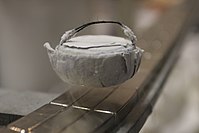
Photo from wikipedia
Fault current limiters are essential devices used to protect the power system and its equipment against high levels of fault current, which are growing up due to the increase of… Click to show full abstract
Fault current limiters are essential devices used to protect the power system and its equipment against high levels of fault current, which are growing up due to the increase of new power sources. This paper proposes a novel design of a Hybrid Superconducting Fault Current Limiter (Hybrid SFCL), which is composed basically by thyristors in series with a superconducting element. This branch is connected in parallel to an air-core reactor, which improves limitation and ensures the safe operation of the superconductor element. Another advantage of this topology is the use of the voltage drop in the superconductor as an input parameter to the controller. This voltage is used to detect the fault, which avoids the need for current sensing and, consequently, reduces the manufacturing costs. In this work, the PSCAD/EMTDC software was employed to model the Hybrid SFCL in a simplified network and the 2G superconducting tape, which was modeled considering the thermal-electric analysis. The results show that the fault current is efficiently limited, and the developed controller strategy has shown excellent performance. Also, the proposed system guarantees a fast recovery time, in the order of 500 ms, which is a good advantage when compared to the conventional resistive SFCL.
Journal Title: Journal of Microwaves, Optoelectronics and Electromagnetic Applications
Year Published: 2021
Link to full text (if available)
Share on Social Media: Sign Up to like & get
recommendations!